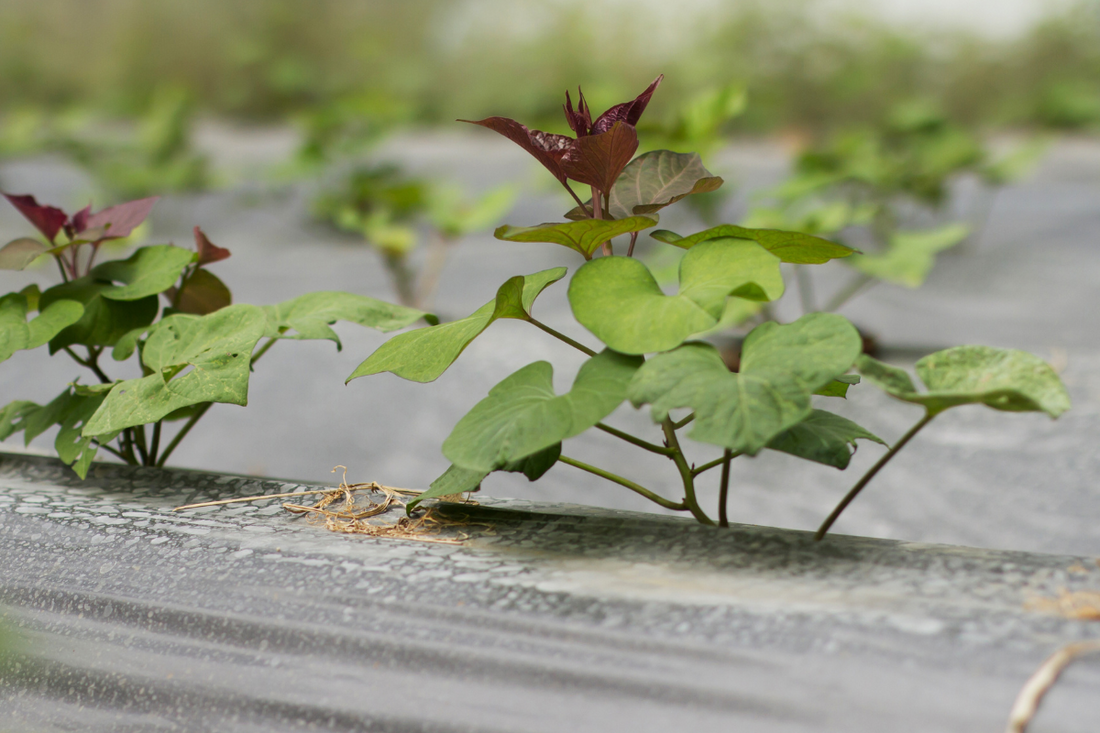Historically, sweet potatoes have been a vegetable that was primarily grown in the southern states. But the introduction of fast-maturing varieties like Beauregard and Georgia Jet provides a way for our northern neighbors to grow delicious sweet potatoes. Even if you only have 3 months of warmer weather, you can still grow sweet potatoes in your backyard garden.
Another way to improve sweet potato performance in cooler regions is to use the black plastic method. Black plastic has been used in commercial agriculture for years as a way to reduce weed pressure for vegetables like tomatoes, peppers, and watermelon. But it can also be used to warm the soil for heat-loving crops like sweet potatoes.
This black plastic method has proven to be very effective in the New England area and other northern states. Growers using this method have been able to double their yields compared to traditional in-ground planting. As a result, they are now able to closely match the yields seen in traditional sweet potato states like Louisiana, Georgia, Tennessee, and North Carolina.
Preparing the Sweet Potato Planting Mound
Commercial growers use tractors to create mounds and lay black plastic on top of the soil, but it can also be done manually on a small scale. Start by preparing a large mound or ridge in your garden along your intended sweet potato planting row. Cultivate your garden soil and use a rake or garden hoe to mound the soil into a ridge. The ridge should be at least 12" wide and approximately 12" high.
After the ridge is prepared, cover it with black plastic so that the plastic covers the top and sides of the ridge. Rake soil over the sides and ends of the black plastic to hold it in place. Doing this will significantly warm your soil and allow you to plant sweet potatoes earlier.
The wide ridge of loose soil will also help your sweet potatoes grow large and smooth. Sweet potatoes will produce more uniform yields in loose soil compared to hard, clumpy soil. If your soil is naturally hard, consider adding compost to soften the mound.
Planting on Sweet Potatoes on Black Plastic
Plant your sweet potatoes in the late afternoon if possible. Planting in the middle of the day can result in low plant survivability due to intense heat and plant stress. Also try to pick a day when wind is minimal, as high winds can quickly dehydrate newly planted sweet potato plants.
Use a knife or garden trowel to poke slits in the black plastic on top of the ridge you created. Poke the slits along the center of the ridge and allow for 12" of space between slits. A 12" plant spacing will produce average size sweet potatoes. If you have plenty of room and want to grow jumbo sweet potatoes, consider a 15" to 18" spacing between slits.
Push your sweet potato plants through the slits and into the soil so that the roots are covered. We recommend pouring a cup or two of water into the planting hole. This will help keep the roots moisturized until they can establish in their new soil. After adding water, use your hand to firm the soil around the sweet potato plant so that it sits upright through the slit in the plastic.
Growing and Harvesting Your Sweet Potatoes
The black plastic covering on the mound will help to preserve soil moisture. But if you're not getting rain at least once a week, you'll want to water the sweet potatoes. You can do this via an overhead sprinkler or simply pour water into the holes in the plastic.
Keep track of your planting date and the listed maturity date for the variety or varieties you're growing. Once the plants have reached maturity, pull back the plastic and harvest your sweet potatoes. They should be in large bunches below each slit you created and should be easy to pull in the soft soil of the ridge you created.

